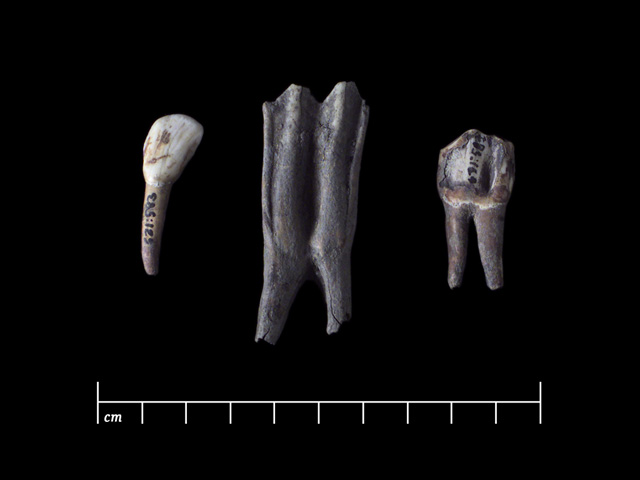 STUDIO PHOTOGRAPHS
STUDIO PHOTOGRAPHSIntroduction | Research | People | Tools
 STUDIO PHOTOGRAPHS
STUDIO PHOTOGRAPHS
BOVINE TEETH (TYA 631: 583a)
Type: Front tooth, molar tooth and premolar tooth of bovine (Bos taurus).
Use: Cattle (faunal residue).
Site: Raisio, Ihala, Mulli abode.
Period: Viking Age / Crusade Age / Early Middle Ages.
Dating: 980-1220 A.D.
Photographer: Antti Huittinen.
The oldest ostheological proof of cattle-breeding in Finland has been dated to the late Bronze Age, (i.e., to the years 1000-500 B.C.) The bone finds in the Mulli abode show that besides farming, hunting and fishing, also cattle-breeding played an important role as a source of livelihood. In the settlement site, bovine, sheep, goats, swine, and chicken were raised. The cows gave milk in summer when they calved. In the winter, the nourishment of the livestock was scanty and therefore the cows were dry, i.e., they didn't provide milk. Since milk does not keep very long without preparation, it was usually soured or churned into butter or cheese.
In the old times, the beef cattle was slaughtered usually once a year, in the autumn. Slaughtering was men's job and the tools for that were the ax and the sheath-knife. Everything possible was used of the bovine: meat, entrails, fat, blood, also leather and horns. From the leather, hides were curried. These served as material for clothes and were possibly also used in bartering. The meat was preserved either by leavening, drying, or smoking. Salting may have been rare because the salt was an imported good. Fresh meat, roasted or boiled, was served only immediately after the slaughtering in the autumn, or on some special occasion.
Other pictures:
Other related topics:
Coordinates: x=110, y=518, 1st layer.
Introduction | Research | People | Tools